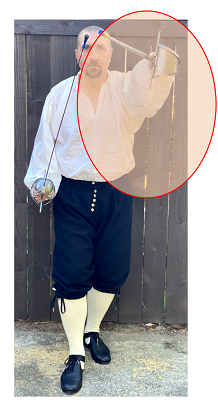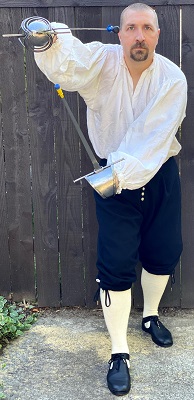Principles of offense
While never stated explicitly, Swetnam’s attack sequences all have one thing in common: the opponent’s weapon is offline. This is either due to the opponent leaving their point offline, as we see in some of the earlier cut-and-thrust guards from authors like Achille Marozzo[1], or by luring the opponent’s weapon away with a feint.
“…for so soone as thou seest thy enemie beare his point steadie in anie guard, whether it bee high or low, as if hee doe beare his point aloft, then step in…”
Second, attacks are aimed at the most convenient target, not necessarily the most lethal one. Swetnam is virtually alone among fencing masters in recommending non-lethal attacks. There are several reasons for his attitude, ranging from the fact that the winning fencer is less likely to have legal trouble if their opponent is disabled rather than killed, to the pious belief that God disapproves of killing. However, Swetnam is by no means a pacifist, and is teaching potentially lethal techniques.
“To know the place, this may be taken in three wayes, … it is chiefly meant here the place offence; thou must marke which is the nearest part of thine enemie towards thee, and which lieth most unregarded, whether it be his dagger hand, his knee, or his leg, or where thous maist best hurt him at a large distance without danger to thy selfe, or without killing of thine enemy.”
“…yet rather hurt, then be hurt, and rather kill, then be killed, if there be no remedie.”
Third, all attacks are made on a lunge. This is very similar to other rapier masters of the time, and quite distinct from earlier English swordplay which used more moderate steps.
“… when thou intendest to offend thy enemy, either with blow or thrust, then steppe forth with thy right foote, and hand together, but keepe thy left foote fast moored like an anchor…” (p. 87)
Forth, each attack (or preplanned sequence of attacks) should be discrete. Once the planned attack has been made or has been foiled, the attacker should draw back into their good guard and reassess before stepping in to measure again. Once again, this similar to other rapier masters and is distinctly from earlier swordplay. Earlier masters such as Silver and Marozzo tend to flow continuously from attack to attack, without constant recovery to a single central guard.
“…the space which in this place I will speake of, is to advise thee to keepe a certaine space betwixt every assault, I meane if thou charge thy enemy thy enemy either with blow or thrust, recover thy weapons into their place, and draw thy selfe into thy guard againe, and so preparing thy selfe for to defend, and likewise to make a fresh assault with discretion, but not chargeth thy enemy rashly or furiously, for hastinesse is foolishness: for if fury have the upper hand, and so you both strike and thrust, without reason and judgement, I say in such a case the skillfulest man that is, may be so well hit as he hit another.”
Fifth, attacks are outside of the defensive zone of the opponent’s dagger. While Swetnam mentions a “fore right thrust” or straight attack, almost all attacks used in his examples are angled shots designed to evade a dagger parry. One way to visualize this is to imagine the zone defended by the dagger as a single large shield. (Figure 8) The attacker’s arm is angled to reach outside of that shield, and the rapier then angles back in to reach the target. The attack does not need to be made in opposition in the Italian fashion because the defender’s rapier has already been taken out of the equation by the attacker’s dagger. The fight has been reduced to a competition between the attacker’s rapier and the defender’s dagger, a situation which favors the attacker.
Figure 8. Attacks are aimed at targets outside the red circle whenever possible.

This principle also plays into Swetnam’s preference for opening every attack sequence with a feint. If the feint is made within the zone which is easily defended by the dagger, the best response from the defender is to parry with the dagger and counter-attack with the rapier. This leaves the attacker in an extremely poor position. Therefore, the initial attack is outside the defensive zone of the dagger, forcing either an unnaturally wide dagger parry which the attacker can then disengage around, or an attempt to parry with the rapier, which is slower and less dangerous to the attacker.
Finally, the dagger comes forward with the attack. As the attacker extends their rapier towards a vulnerable portion of the defender’s body, the defender has a limited range of options with their rapier. The dagger comes forward with the attack in preparation for exploiting the defender’s response. In the simplest scenario, the defender’s rapier doesn’t move. The attacker’s dagger takes control of the defender’s rapier on the way in and the attacker’s rapier continues on the way to the target. Alternately, the defender moves their rapier to parry the attack. The defender’s rapier is then out of its guard position and the attacker’s dagger can then be used to keep the defender’s rapier offline while the attacker’s rapier is free to find a new target. Finally, the defender can choose to make a risky counter-attack. In this case, the dagger’s forward position makes it easier to parry the counter-attack far ahead of the attacker’s body.
“…for in your offence the dagger hand should be bourne out so farre as the rapier hand goeth, which must be done by practice and great carefulnesse; for many when they doe make their assault, they will put out their rapier, and plucke in their dagger, thereby endangering themselves greatly: for except that the dagger arme be kept straight, and borne out stiffe, it is hard to defend either blow or thrust.” (p. 90)

Techniques of offense
There are several basic attacks that are repeated throughout the manual.
Plain thrust
The straight thrust or straight lunge of Italian rapier at the time plays essentially no role in Swetnam’s style. He refers to “plain thrusts” and “fore right thrusts” (forthright) in a few places, but they are rare. This is most likely due to the fact that such attacks can be parried with the dagger, leaving the defender’s rapier free to counter-attack, and thus pose an unacceptable risk.
Right Stock (Stokata)
One of his more common attacks is a Right Stock, an upwards thrust to the stomach made with a straight arm. This attack is designed to go underneath a possible dagger parry. It is important that the body be held upright during this attack, not leaning forward, in order to make a quicker recovery.
“A Right Stock, or Stockada, is to bee put in upwards with strength and quicknesse of the bodie, and the guard for the putting in a stoke is leaning so farre backe with your face and bodie as you can, and the hilts of your Rapier so neere the ground, or so low as you can, but of this guard I have spoken sufficiently alreadie.” (p. 133)
Slope Stock
Another basic attack is a Slope Stock, a thrust where the rapier arm crosses over to the left side of the attacker’s body, with the knuckles pointing to the left. This attack is made to defender’s right chest, head, or shoulder. Similar to the “punta reversa” of Italian rapier, this attack is nearly impossible to parry with a dagger.
“A slope Stocke is to be make unto your enemies breast, or unto his Rapier shoulder, if hee doe looke over his Rapier, but in putting it in, you must wheale about your Rapier hand, towards your left side turning your knuckles inward, this thrust being put in slopewise as aforesaid, will hit thy enemie which lieth upon the Crosse-guard, or the Carelesse-guard, or the Broad-ward, when a right Stocke or plaine fore right thrust will not hit.” (p. 113)

Imbrokata
The final common attack from Swetnam is the Imbrokata, an attack around the outside of the defender’s dagger into the left arm, shoulder, or the head. Once again, the attack reaches around the dagger’s defensive zone rather than through it.
“An Imbrokata, is a falsifying thrust, first to proffer it towards the ground, so low as your enemies knee, and then presently put it home unto your enemie Dagger-shoulder, or unto anie part of his Dagger-arme, for hee will put down his Dagger to defend your fained thrust, but cannot recover his Dagger againe before you have hit him in the Dagger arme, Shoulders of Face…” (p. 113)

Wrist blow
Swetnam repeatedly says that thrusts are always better than cuts. Wrist blows (stramazone) are considered slightly better than other cuts, but are still inferior to thrusts in almost all situations.
“Againe, and againe I say, strike not one blow in a fight, at what weapon soever thou fightest withall, except it be a wrist blow, and that you may aswell doe with a rapier, as with a sword, for a wrist blow consumeth but alittle time, yet better use no blow at all, but continually, thrust after thrust…”
“if you doe strike, not to over-strike your Sword, but so strike your blow as you may recover him into his place hastily againe; for in fight if you doe strike, you must forebeare strong blowes, for with a strong blow, you may fall into divers hazzards; therefore strike an easie blow, and doe it quicke, but to thrust, and not strike at all, is to thy best advantage.” (p. 121)
[1] Achille Marozzo, Opera Nova, 1536